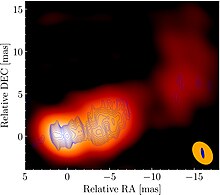

| 3C 345 | |
|---|---|

Image of 3C 345 by the Hubble Space Telescope
| |
| Observation data (Epoch J2000) | |
| Constellation | Hercules |
| Right ascension | 16h42m 58.8s[1] |
| Declination | +39° 48′ 37″[1] |
| Redshift | 0.5934 [1] |
| Distance | 5.497 Gly |
| Type | Opt.var.;HPQ, FSRQ |
| Apparent magnitude (V) | 16.6[1] |
| Notable features | superluminal jet |
| Other designations | |
| 4C +39.48, LEDA 084767[1] | |
| See also: Quasar, List of quasars | |

3C 345 is a blazar/flat spectrum radio quasar located in the constellation of Hercules. It is noted for hosting a superluminal jet[3] and its variability in almost all wave bands.
3C 345 has an active galactic nucleus that has been categorised as a blazar or as a flat spectrum radio quasar. The host galaxy of 3C 345 is an E3 elliptical galaxy without prominent peculiar characteristics.[4]
When observed in radio waves, 3C 345 features a compact region with a radio jet emanating from it for 3 arcseconds and ending at a hot spot.[3] The jet appears straight for 4 milliarcseconds (mas)[3] but then curves northwards. Hot spots are visible at the counterjet direction in radio images.[5] There is also a faint halo.[3] The jet has been found to emit X-rays, up until 0.2 arcseconds from a radio hot spot, which could be in reality a bend of the jet.[5]
The components of the jet have been found to move by about 0.25–0.42 mas, which at the distance of the jet represent apparent speeds that are 5 to 15 times faster than the speed of light.[6] The radio jet exhibits superluminal motion for 0.12 to 12 mas, with apparent speeds that accelerate from ~5c to ~15c within 0.3 mas. Within the jet lies a stationary feature ~0.1 mas (with corresponds to about 0.7 pc at the distance of 3C 345) from the core, which has also been found in other blazars.[6] The viewing angle between the jet axis and the line of sight is calculated to be about 5°.[6]
3C 345 has been known to fluctuate in brightness. For example, it brightened from magnitude 17.2 to 16.0 between 10 April 2018 and 8 May 2018 when observed in R band.[7] A bright GeV gamma-ray flare was observed by the Fermi Gamma-ray Space Telescope on 31 May 2017, as the flux increased by 40 times above average.[8] The flares in 2009 were observed simultaneously in γ-rays, X-rays and optical/UV, while there was a lag before they were observed in radiowaves.[9] A long term variability study indicates flares every 3.5 to 4 years, coinciding with the appearance of new features in the radio jets.[10]
It has been suggested that the source of the fluctuation is the presence of a binary supermassive black hole, with the two similar black holes with masses about 7.1×108 M☉ which are separated by around 0.33 pc and orbit each other with a period of 480 years. The second black hole perturbates the accretion disk, resulting to fluctuations in activity.[11] The X-rays observations indicate that the nuclear region is hidden behind a compton thick absorber with a column density of NH ≃ 1025 cm−2 that covers 75% to 85% of the X-rays source.[12]
|
| |||||||||||||
|---|---|---|---|---|---|---|---|---|---|---|---|---|---|
| |||||||||||||
| Stars |
| ||||||||||||
| |||||||||||||
| |||||||||||||
| |||||||||||||
| Galaxies |
| ||||||||||||
| |||||||||||||
| |||||||||||||